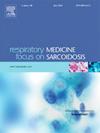慢性阻塞性肺疾病患者体位控制任务中膈外吸气肌表面肌电图的价值
IF 3.5
3区 医学
Q2 CARDIAC & CARDIOVASCULAR SYSTEMS
引用次数: 0
摘要
在慢性阻塞性肺疾病(COPD)患者中观察到姿势控制和膈肌并发功能障碍。测量横膈膜激活的传统方法是经食管横膈膜肌电图(EMGdi),这是一种昂贵且相对有创的方法。膈外吸气肌表面肌电图可作为肌动电位的有用生理指标。本研究比较了9例慢性阻塞性肺病患者(5名男性;年龄:65±6岁;第一秒用力呼气量:预估60±27%)。在不同的支撑面(稳定/泡沫)、手臂运动频率(单次/重复)和呼吸模式(正常/呼气末屏气)条件下,在6个姿势控制任务中,同时记录EMGdi、sEMGscm、semgscalal和sEMGic振幅。肌电图振幅归一化到每块肌肉的最大自愿收缩。采用Bonferroni-Holm事后检验和Bland-Altman分析的线性混合模型。肌电-任务交互作用显著(p = 0.0223)。在所有任务中,EMGdi的振幅都显著低于sEMGic (p <;0.0001至0.0007),而经Bonferroni-Holm校正后,EMGdi与sEMGscm或EMGdi与semgscale之间无显著差异(p = 0.019-0.858)。Bland-Altman分析表明,EMGdi与sEMGscm和semgscale之间存在合理的一致性(平均偏差:1.8%和- 3.7%),而sEMGic的总体偏差明显更高,为- 20.7%。这些发现表明,在COPD患者的姿势控制评估中,sEMGscal和sEMGscm都可以作为有用的EMGdi生理标志物。新,值得注意的。这项研究强调了膈外吸气肌表面肌电图作为COPD患者姿势控制任务中经食管膈肌电图的生理标记的潜力,从而减少了对昂贵和侵入性测量的需求。本文章由计算机程序翻译,如有差异,请以英文原文为准。
The value of extra-diaphragmatic inspiratory muscle surface electromyography during postural control tasks in patients with chronic obstructive pulmonary disease
Concurrent dysfunctions in postural control and diaphragm are observed in patients with chronic obstructive pulmonary disease (COPD). Measuring diaphragm activation traditionally involves transesophageal diaphragm electromyography (EMGdi), which is costly and relatively invasive. Extra-diaphragmatic inspiratory muscle surface electromyography may serve as a useful physiological marker for EMGdi. This study compared EMGdi amplitude with surface EMG amplitude of other inspiratory muscles, including sternocleidomastoid (sEMGscm), scalene (sEMGscal), and parasternal intercostal muscles (sEMGic) during postural control tasks in nine patients with COPD (5 males; age: 65 ± 6 years; forced expiratory volume in the first second: 60 ± 27 % predicted). Simultaneous recordings of EMGdi, sEMGscm, sEMGscal, and sEMGic amplitudes were obtained during six postural control tasks involving upright standing with ballistic arm movements under different conditions of support surface (stable/foam), arm movement frequency (single/repetitive), and breathing modes (normal/breath-hold at end-expiration). EMG amplitudes were normalized to each muscle's maximum voluntary contraction. A linear mixed model with Bonferroni-Holm post-hoc tests and Bland-Altman analyses were performed. There was a significant EMG-by-task interaction (p = 0.0223). The amplitude of EMGdi was significantly lower than sEMGic across all tasks (p < 0.0001 to 0.0007), while no significant differences were observed between EMGdi and sEMGscm or EMGdi and sEMGscal after Bonferroni-Holm correction (p = 0.019–0.858). Bland-Altman analyses indicated reasonable agreement between EMGdi and both sEMGscm and sEMGscal (mean biases: 1.8 % and −3.7 %), while sEMGic had a significantly higher overall bias of −20.7 %. These findings suggest that both sEMGscal and sEMGscm can serve as useful physiological markers for EMGdi in postural control assessments in patients with COPD.
NEW & NOTEWORTHY.
This study highlights the potential of extra-diaphragmatic inspiratory muscle surface electromyography as a physiological marker for transesophageal diaphragm electromyography during postural control tasks in patients with COPD, thereby reducing the need for costly and invasive measurements.
求助全文
通过发布文献求助,成功后即可免费获取论文全文。
去求助
来源期刊

Respiratory medicine
医学-呼吸系统
CiteScore
7.50
自引率
0.00%
发文量
199
审稿时长
38 days
期刊介绍:
Respiratory Medicine is an internationally-renowned journal devoted to the rapid publication of clinically-relevant respiratory medicine research. It combines cutting-edge original research with state-of-the-art reviews dealing with all aspects of respiratory diseases and therapeutic interventions. Topics include adult and paediatric medicine, epidemiology, immunology and cell biology, physiology, occupational disorders, and the role of allergens and pollutants.
Respiratory Medicine is increasingly the journal of choice for publication of phased trial work, commenting on effectiveness, dosage and methods of action.
 求助内容:
求助内容: 应助结果提醒方式:
应助结果提醒方式:


